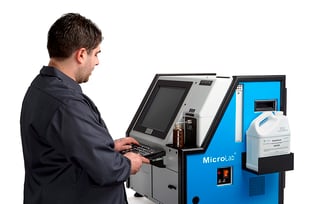1. It takes a lot of specialized instrumentation
The days of needing a laboratory full of specialized equipment to do oil analysis are long gone. The MicoLab® all-in-one oil analyzer combines four separate analytical instruments into one compact device. The MicroLab is used to test for elemental analysis, viscosity, oil chemistry and particle contamination. It only requires a small amount of space and is designed to be operated in non-lab environments, like garages, so it is easy to incorporate into your existing work space.
MicroLab is a “lab in a box”

2. It’s hard to do
The MicroLab analyzer is completely automated. One 5-ounce sample of oil is connected to the MicroLab with the intake straw and the tests are all performed at the push of a button without further user intervention. The fluidics system moves the sample throughout the test chambers automatically. There is no sample prep so it eliminates user errors that can alter results. After the sample is run, the system cleans itself in preparation for the next sample and prints out an easy-to-understand report showing engine oil analysis results.
MicroLab is as easy to operate as an ATM
3. It takes a long time
A comprehensive oil analysis can be performed on the MicroLab in about 15 minutes. This includes running the oil sample through tests for elemental analysis, viscosity, oil chemistry and particle contamination. For mobile assets like trucks and buses this is especially important as maintenance professionals need answers while the vehicle is in the shop. If it takes days to get results back, often that vehicle is long gone and that could be the time failure occurs. MicroLab results are available in 15 minutes compared to days or weeks with outside labs.
MicroLab provides real-time decision making
4. I need to be a trained chemist
Interpretation of the analytical results is done automatically by the MicroLab’s embedded expert system. The artificial intelligence of this system combines equipment information, analysis results and a proprietary database built from 20 years of real-world oil analysis experience to provide the interpretation of the analytical results. The easy-to-understand reports have color-coded alarms and diagnostic statements of recommended maintenance actions
MicroLab is like having your own oil specialist on staff
5. It won’t help me save money on maintenance
Fleet customers who use oil analysis have achieved considerable savings in three main areas:
- Lower analysis costs
Sending samples to an oil analysis laboratory is certainly preferable to simply not performing any oil analysis. However the costs can really start to add up as you do more frequent analysis. Additionally, the cost of analysis often prevents companies from doing as much analysis as they should. The cost of oil analysis can vary significantly from lab to lab and depending on what parameters are being tested. The cost per analysis on the MicroLab is less than $4 per sample. For example, if you are sending out 25 samples per month at a cost of $50/sample, then the MicroLab can save you $14,000 per year just in testing costs.
- Extended oil drain intervals
Changing oil on an as-needed basis, as opposed to a time or mileage basis can save considerable money on oil, labor, filters, and disposal. On-site analysis can quickly monitor the health of the oil and tell you whether it needs to be changed or if the vehicle is okay to be driven longer before changing the oil. Reducing the number of oil changes even by just one per year on each vehicle can really add up over a fleet of hundreds or thousands. For example, the average cost of an oil change for a transit bus is $200 so eliminating one oil change per vehicle across a fleet of 750 buses can save $150,000 in a year. Extending the oil drain intervals not only saves money but can help fleets achieve green initiatives by reducing their oil disposal and oil consumption.
- Early detection of failures
Early detection of engine or transmission issues allows fleets to perform preventative maintenance on small issues rather than having the expense of catastrophic failures. It can be the difference between $2,500 to replace a failed EGR system and up to $30,000 to replace the engine. For many companies the money lost by stopped production can far outweigh the cost of repairing the failure. On-site oil analysis can catch these impending failures in time to take preventative actions or make a small repair, saving money on repairs and avoiding extended downtime.
MicroLab provides measureable cost savings
To see how much MicroLab could save you, try our saving calculator.


